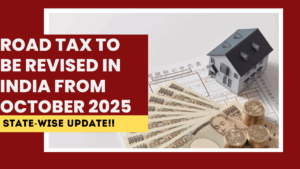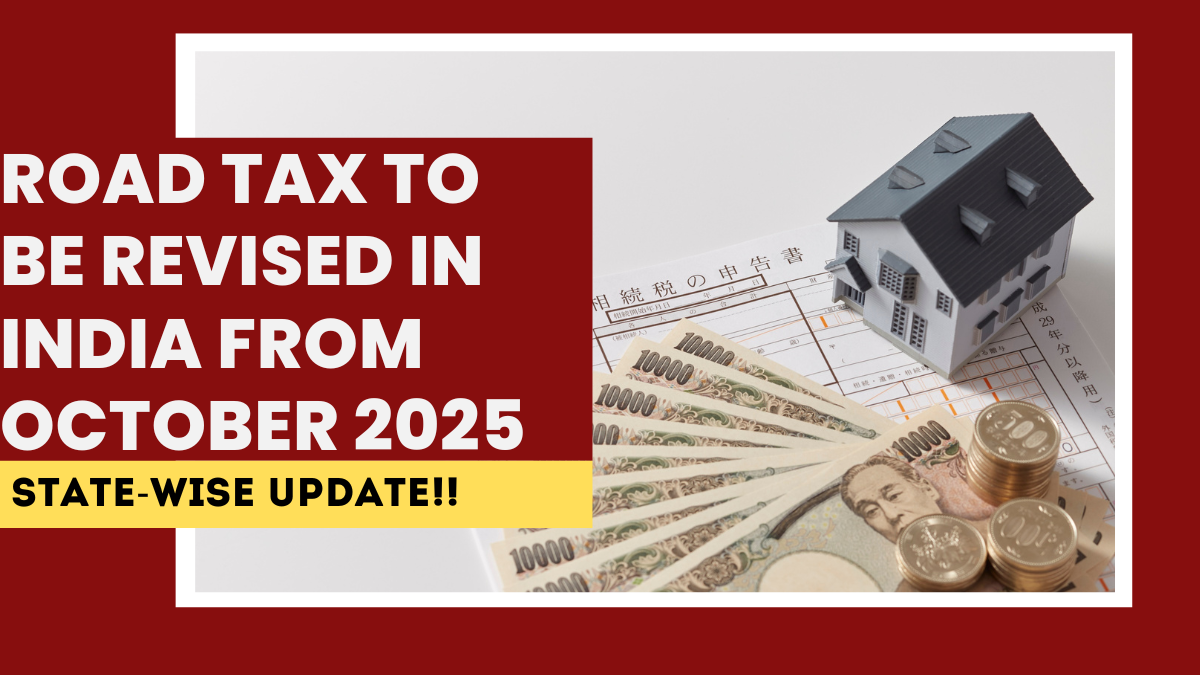Buying a new car or two-wheeler in India is about to get more expensive starting October 2025. The central government, in collaboration with state transport departments, has announced a road tax revision across India, affecting the overall vehicle registration cost. This is one of the biggest changes to motor vehicle taxation in recent years, and it will directly impact car buyers, automakers, and the automobile market as a whole.
The revised slabs are expected to bring more uniformity in tax collection, reduce loopholes in interstate vehicle registration, and increase state revenues. However, for buyers, it translates to higher upfront costs when purchasing new vehicles.

Why Road Tax Revision in 2025?
Road tax contributes significantly to state government revenues and funds road construction and infrastructure development. The revision in India road tax 2025 is driven by:
-
Rising Vehicle Sales: With India seeing record growth in SUV and EV sales, the government is restructuring taxes to match demand.
-
Inflation Adjustment: Current tax slabs were framed years ago, and adjustments are necessary to account for inflation.
-
Uniformity Across States: Many states levy road tax differently, leading to confusion for interstate buyers. The new rules aim to streamline the process.
-
Green Mobility Push: Higher taxes on diesel and large-capacity vehicles will discourage polluting models, while EVs may see lower rates.
New Road Tax Slabs from October 2025
The revised road tax rules in India will vary across states but follow a central guideline.
-
For Petrol Cars:
-
Cars under ₹10 lakh: 10–12% of ex-showroom price.
-
Cars ₹10–20 lakh: 12–15%.
-
Cars above ₹20 lakh: 15–18%.
-
-
For Diesel Cars:
-
Diesel cars attract 2–3% higher road tax compared to petrol cars.
-
SUVs above ₹20 lakh could attract up to 20% road tax.
-
-
For Electric Vehicles (EVs):
-
EVs under ₹15 lakh: 5–6%.
-
EVs above ₹15 lakh: 8–10%.
-
Some states may continue to waive EV road tax till 2027 under green incentives.
-
-
For Two-Wheelers:
-
Under ₹1 lakh: 8–10%.
-
Above ₹1 lakh: 10–12%.
-
Electric two-wheelers: 5%.
-
State-Wise Road Tax Revisions (Highlights for October 2025)
-
Delhi NCR: Higher slabs for diesel SUVs; EVs to get 50% concession till March 2027.
-
Maharashtra: Road tax to increase by 2% for vehicles above ₹15 lakh; incentives for EVs remain.
-
Karnataka: Uniform road tax across Bengaluru and tier-2 cities; SUVs to be taxed highest.
-
Gujarat: 1% additional surcharge for luxury cars above ₹25 lakh.
-
Tamil Nadu: No major revision for budget cars, but significant hike for premium cars.
How This Affects Car Buyers
For anyone planning to purchase a vehicle after October 2025, the changes will directly affect affordability:
-
Higher On-Road Prices: Expect cars to cost ₹50,000–₹2 lakh more depending on the segment.
-
Diesel Cars Hit Hardest: With BS7 norms and higher road tax, diesel cars are becoming less attractive.
-
EV Advantage: Buyers opting for electric cars can save up to ₹1 lakh in taxes compared to petrol or diesel models.
-
Two-Wheeler Impact: Budget scooters and bikes under ₹1 lakh see marginal changes, but premium two-wheelers will cost more.
Industry Impact
Automakers and dealers will also feel the effect:
-
Slowed Sales in Premium Segments: Higher taxes may reduce demand for large SUVs and luxury sedans.
-
Boost for EV Sales: Lower road tax makes EVs more competitive in the ₹10–20 lakh range.
-
Inventory Management: Dealers may push aggressive sales campaigns in September to clear pre-tax revision stocks.
-
Shift in Buyer Preferences: Families may opt for CNG or hybrid models to balance fuel and tax savings.
What Buyers Should Do Before October 2025
-
Advance Purchase: If you plan to buy a car soon, completing the purchase in September 2025 could save significant money.
-
Compare EV Benefits: Many EV models will enjoy lower registration costs, making them financially attractive.
-
Check State Policies: Some states may delay full implementation, giving a small window for buyers.
-
Calculate Total Cost of Ownership: Beyond road tax, consider fuel savings and resale value before deciding.
Future Outlook
The road tax revision in October 2025 signals India’s move toward greener and more sustainable transport policies. While buyers face higher upfront costs, the market will likely shift toward eco-friendly vehicles, aligning with BS7 norms and global trends. States are expected to periodically review and revise these slabs every 3–5 years going forward.
FAQs
When will the new road tax rules be implemented?
The revised road tax slabs will take effect from October 2025 across India.
Which vehicles will be most affected?
Diesel SUVs and luxury cars will see the sharpest increase, while EVs will benefit from lower slabs.
Will electric vehicles continue to get tax benefits?
Yes, EVs will enjoy reduced road tax rates, and some states may waive taxes entirely till 2027.
How much more will cars cost after October 2025?
Cars may cost ₹50,000–₹2 lakh more depending on segment, engine type, and state tax slabs.
Should I buy a car before the revision?
Yes, if you plan to buy a petrol or diesel vehicle, purchasing before October 2025 can help you avoid higher costs.
Click here to know more.
